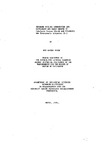OFFSHORE FOULING COMMUNITIES AND SETTLEMENT AND EARLY GROWTH IN Tubularia larynx (ELLIS AND SOLANDER) AND Pomatoceros triqueter (L.)
| dc.contributor.author | MOATE, ROY MARTIN | |
| dc.contributor.other | School of Biological and Marine Sciences | en_US |
| dc.date.accessioned | 2013-11-14T09:59:30Z | |
| dc.date.available | 2013-11-14T09:59:30Z | |
| dc.date.issued | 1985 | |
| dc.identifier | NOT AVAILABLE | en_US |
| dc.identifier.uri | http://hdl.handle.net/10026.1/2693 | |
| dc.description | Merged with duplicate record 10026.1/663 on 28.02.2017 by CS (TIS) | |
| dc.description.abstract |
The horizontal and vertical distribution of the macro-fouling organisms, both flora and fauna, associated with offshore structures was studied. Offshore buoys located around the coasts of Britain (38) and Norway (10), were used as sites for the collection of material. Sites were visited annually, when possible, over the period 1978-1983. Numerical clustering techniques and indicator species analysis were used to reveal broad geographical categories in the fouling community data. Eight major Site Groups were identified amongst U.K. sites, and three from Norway; whilst within each site group characteristic species were also identified. The frequency and abundance of Tubularia larynx and Pomatoceros triqueter at both the British and Norwegian sites indicated that each species was a 'successful' member of the fouling communities examined, and able to rapidly colonize newly immersed hard substrata. Light microscopy, histochemical techniques and electron microscopy were used to investigate the mechanisms of substrate attachment and settlement in both species. It is postulated that the secretion of an acidic 'adhesive' mucosubstance prior to the secretion of the calcareous tube in Pomatoceros may contribute to the successful colonization of hard surfaces; whilst a rapid chitin tanning process was identified during 'growth' of the aboral pole of the settling actinula larva in Tubularia, as well as in the subsequent vegetative growth of 'primary' stolen tips. In addition, a gregarious settlement-response was identified in Pomatoceros larvae. Several growth experiments were performed on each animal and a multifactorial approach was used to investigate the conditions for early growth in each organism. Both species were capable of rapid growth immediately following settlement. 'Tubegrowth' was recorded in Pomatoceros under a wide range of temperature and salinity conditions; being greatest amongst animals maintained in combinations of high temperature (15-200C) and high salinity (26-34‰), whilst the secretion of new tube was much reduced at 60C and 10‰. In Tubularia, although growth was rapid between 60C and 18°C., the hydroid was more strictly marine and both stolonic growth and hydranth production were restricted in salinities below 28‰. | en_US |
| dc.description.sponsorship | THE ADMIRALTY MARINE TECHNOLOGY ESTABLISHMENT PORTSMOUTH | en_US |
| dc.language.iso | en | en_US |
| dc.publisher | University of Plymouth | en_US |
| dc.title | OFFSHORE FOULING COMMUNITIES AND SETTLEMENT AND EARLY GROWTH IN Tubularia larynx (ELLIS AND SOLANDER) AND Pomatoceros triqueter (L.) | en_US |
| dc.type | Thesis | |
| plymouth.version | Full version | en_US |
| dc.identifier.doi | http://dx.doi.org/10.24382/4276 | |
| dc.identifier.doi | http://dx.doi.org/10.24382/4276 |
Files in this item
This item appears in the following Collection(s)
-
01 Research Theses Main Collection
Research Theses Main


